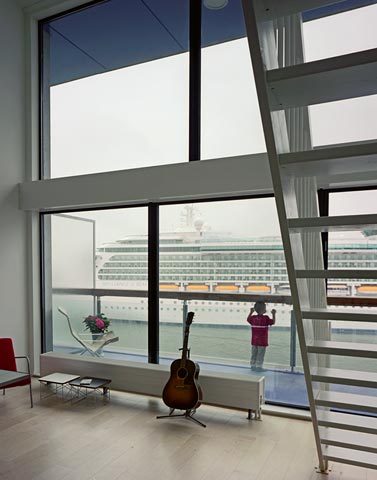
Silodam apartment, Amsterdam
designed by MVRDV architects
When the glass Richard Meier towers on the Hudson in the West Village appeared a few years ago, they were heralded as a new phenomenon. At least in New York. Having lived much of the last 15 years in Europe–the last few behind double height windows overlooking Amsterdam–I was surprised to see the furor these new buildings elicited. I knew that New York (and the US in general) had slept through the 90s, architecturally speaking, but now in the 00s, things were changing. So, what was the fuss all about?
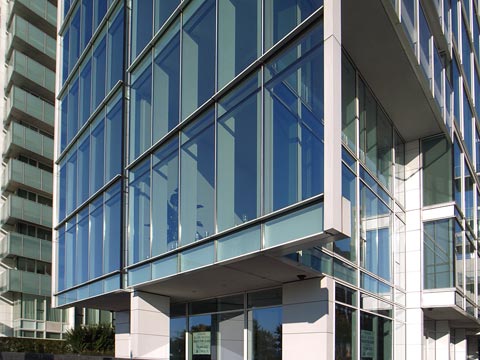
Richard Meier in the West Village
Last Sunday in the NY Times, the issue was further inflated, if not examined, in an article by Penelope Green:
In New York City, where the streetscape is being systematically remade by glassy towers like the W, which have been spreading like kudzu in the seven years since the first two terrarium-like Richard Meier buildings went up on the West Side Highway, the lives of the inhabitants are increasingly on exhibit, like the performance art wherein the artists “live” in a gallery for 24 hours and you get to watch them napping or brushing their teeth.
It’s not always a pretty picture.
She goes on to reference Curbed, the snarky real estate blog (that I’m addicted to), Hitchcock’s Rear Window, and Sherry Turkle, a psycholgist at M.I.T., who proclaims life in a goldfish bowl “a turning point in form.”
I think there are a number of social trends at work here, and pulling them apart tends to trivialize the matter as Curbed does cheerfully, and Turkle does more ominously:
These buildings, she suggested, tell a story of anxiety, not exhibitionism.
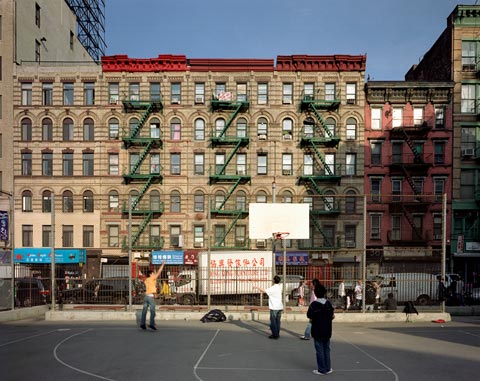
Eldridge Street, Lower East Side tenements
In my view, New York has historically been a city with a clear distinction between public and private spheres. The street was, and is, the grand theater of urban life. People here have always lived in small quarters, sometimes inhumanely crowded together as on the old Lower East Side. The street was the space where people interacted, shopped, and communicated, while the skyline provided the dramatic backdrop. The street grid functioned as an ordering structure for all the energy, commercial and creative, flowing in the city, and the continuous street wall guarded the mini domestic castles of apartment life.
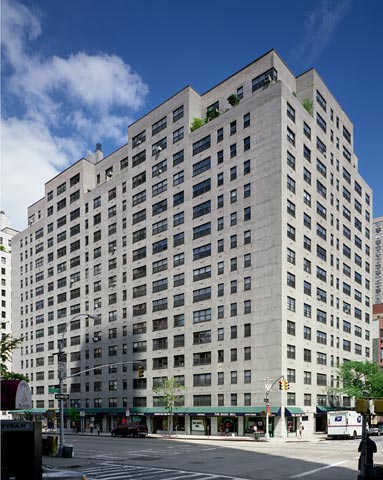
Punch card conformity on the Upper East Side
Modernism called for transparency in architecture, and in New York, that aesthetic conflicted with the notion of protected private space. Corporations embraced the glass curtain wall for economic reasons and efficiency. But there was little to see behind those walls besides endless cubicles and generic corner offices. Ironically, the World Trade Center with its barred pinstripe fenestration demonstrated profoundly its structural weakness. Few developers, however, were willing to risk disturbing the status quo when it came to residential buildings.
After 9/11 something happened in this city that has only been tangentially addressed. Certain fundamentals changed in the way things work, for better or worse. Despite the horror of the event, the city reasserted itself and began moving forward. Crime, already down, continued to plummet. Population increased. People started having families in the city, a dramatic turnaround after decades of flight to the suburbs. And for many, the silly post modern buildings of the 80s and 90s suddenly looked out of date and irrelevant.

Hell’s Kitchen tenements with 90s post modernism
There are those who bemoan the changes that have occurred. Some believe that the city has lost its soul from Disneyfied Times Square to the formerly dark neighborhoods of lower Manhattan. People reminisce endlessly about the ferment of art and music back in the late ’70s when there were cheap apartments, empty streets, and danger lurking. In many ways they are right–more economically marginal activities have decamped to other parts of the city–but it does little good to pine for the past when there is a present being defined by new generations with different priorities and a different internal map of the city.
I have come to believe that in recent years there has been a noticeable shift in the relationship between public and private space in the city. September 11th stripped bare the illusion of security symbolized by the walls, honey-combed rooms, and claustrophobic elevators of our homes. Inside those walls we are all online now, as is pointed out in the Times article, and the definition of community has been redefined. It takes place in real places and virtual ones interchangeably. And as has always been the case, money is the engine of this most commercial of cities. Since 9/11 money has sloshed through the streets of this town like water sweeping away and through all our old haunts.
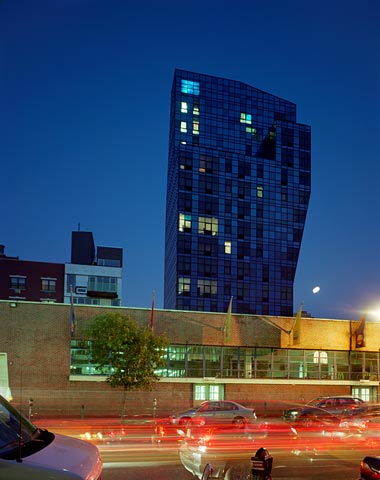
Blue Condo, conspicuous consumption on the Lower East Side
Bernard Tschumi, architect
The new New York is not about hunkering down behind walls. Modernism’s (now ancient) promise of light, air, and transparency is upon us, finally. We all live in glass houses, at least in the virtual world, so we might as well live in them in the real as well. For some it represents a kind of exhibitionism–we have nothing to hide–and there is no shortage of voyeurs with telescopes and cell phone cameras at ready, not to mention the hydra-headed apparatus of homeland security. But for others it is a breath of fresh air–and light–in a place called home.